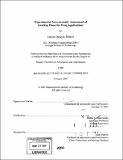Experimental aero-acoustic assessment of swirling flows for drag applications
Author(s)
Mobed, Darius Darayes
DownloadFull printable version (26.38Mb)
Other Contributors
Massachusetts Institute of Technology. Dept. of Aeronautics and Astronautics.
Advisor
Zoltan S. Spakovszky.
Terms of use
Metadata
Show full item recordAbstract
The need for quiet drag technologies stems from stricter requirements for and growing demand of low-noise aircraft. The research presented in this thesis regards the use of swirling exhaust flows capable of generating pressure drag quietly by establishing a steady streamwise vortex. The simple concept of a so called swirl tube, a ducted set of stationary turning vanes, was implemented to experimentally assess the aerodynamic and aero-acoustic behavior of swirling flows. A modular design was chosen for the model-scale wind-tunnel test article based on a full-scale diameter of 1.2 m to allow for the wind-tunnel testing of different swirl angles, including both stable swirling configurations and cases exhibiting vortex breakdown. Analyses of both aerodynamic and aero-acoustic test results indicate that highly swirling stable flows obtain maximum drag coefficients greater than 0.8 +0.04 referenced to inlet area with full-scale overall sound pressure level (OASPL) of 42 dBA ±2 dBA, validating the working hypothesis that swirling flows can generate drag quietly. An advanced deconvolution approach for the mapping of acoustic sources (DAMAS), previously developed at the NASA Langley Research Center, was used to identify and to quantify quadrupole- and turbulent scattering-type noise sources in stable swirling flow cases, radiating from the downstream exhaust core and nacelle trailing edge regions, respectively. (cont.) Cases exhibiting vortex breakdown, found to occur at swirl angle settings exceeding -50', demonstrated noise signatures 10 to 15 dB louder than the stable swirling flows, attributable to the increased scattering noise due to the turbulence of the burst vortex near swirl tube rear surfaces and edges. The practical integration of swirl tubes into aircraft design was assessed based on the conceptual silent aircraft design SAX-40. Integrating swirl vanes into the fan bypass or mixing ducts of aircraft engines is suggested to be capable of generating effective drag at minimal weight cost, benefiting from increased mass flow through the device due to fan pumping. The effects of non-uniform inlet flows on the generation of drag and noise were assessed experimentally and showed a reduction in drag by less than 17% with virtually no noise penalty. The experimental assessment of the swirl tube combined with theoretical engine and airframe integration studies suggest that swirling exhaust flows are capable of generating drag for quiet transport aircraft.
Description
Thesis (S.M.)--Massachusetts Institute of Technology, Dept. of Aeronautics and Astronautics, 2007. Includes bibliographical references (p. 131-133).
Date issued
2007Department
Massachusetts Institute of Technology. Department of Aeronautics and AstronauticsPublisher
Massachusetts Institute of Technology
Keywords
Aeronautics and Astronautics.